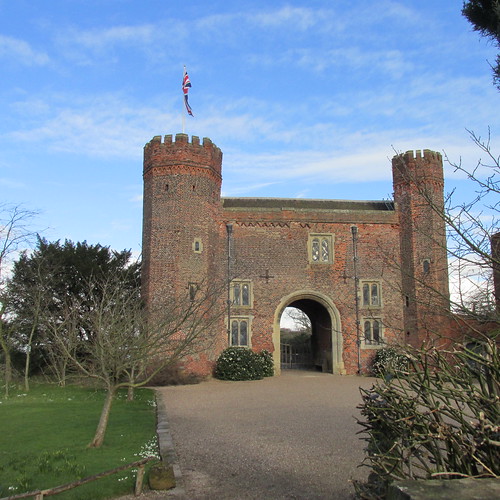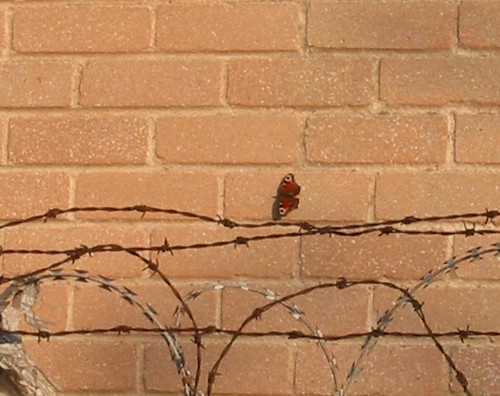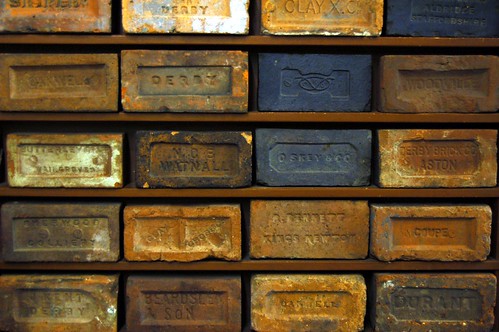When was the last time you looked at a brick wall? I mean really looked at it. I know what you're thinking: "Why would I?" Well, there's a lot more to brickwork than you'd realise. Anyone who has heard the story of the Three Little Pigs knows that bricks create a safe and stable structure in which to live or store goods. But over the millennia of their history they have often been much more than that.
Back in Tudor times bricks were the preserve of the rich. The amount of work involved, in preparing the clay, shaping individual bricks, and firing them, made them an expensive material. Noblemen across England showed off their status by investing in vast brick mansions, often with contrasting-coloured patterns built in.
This is the gateway at Hodsock Priory near Blyth in Nottinghamshire. It dates from the early 16th century and gives a hint of how magnificent the actual house must have been. In spite of the name, Hodsock was never a Priory. The current house is a Victorian replacement, unfortunately.
Bricks have various specialist terms connected to them. For example, the long sides are called stretchers. The short sides are headers. The right-angled edges are called arisses. The dent where the mortar goes is called a frog. The brick height is called the gauge. Tudor bricks are typically much shallower gauge than modern ones.
Bricklaying patterns - or bonds - have changed over the years. For example, modern brickwork tends to be what's known as stretcher bond, where all the long edges face the front.
This mostly came about because of the advent of double skin houses with a cavity between the two walls. The idea was that an air gap would help insulate the house, because air is a poor conductor of heat. But the popularity of cavity wall insulation a few years ago has shown that wasn't true.
Earlier construction used different patterns. This, for example,
is a classic Victorian era bridge over the canal system in Birmingham. (The gate is to allow fire fighters to put hoses into the canal to use them as a water source.) You will notice that the bricks are in alternate courses of headers and stretchers. This is known as English bond. The wall is, of course, two bricks wide because the headers are twice the length of the stretchers. Other bonds include Flemish, which consists of rows of alternate headers and stretchers, with the headers centred on the mid-point of the stretchers,
Here's another pattern - called herringbone. As you can see it's the infill in a half-timbered house. This was a Tudor way of having bricks more cheaply than using them for the whole wall. The infill is called nogging. Aren't brick words wonderful?
And finally we come to what is possibly the most interesting thing about bricks altogether. Some of them have names!
This collection can be found at Derby Silk Mill Museum and shows just a few of the makers who could be found in the area. As you can see, the names are mostly in the frog, or are on the surface that will be cemented against the next course. Not every brick has a name, and a very few have it on a surface that will be visible. And that's where the fun comes in. Sometimes you can find a name on a wall that tells you where the bricks came from. Like this:
(Bonus photo.)
Today's post has been created for Five on Friday.






Lovely post giving me lots of new information. I saw a programme recently about renovating homes. It spent some time explaining how the early bricks were handmade. Now they are bog standard in houses. Fascinating to think they used to be a luxury item. Have a lovely weekend. B x
ReplyDeleteI remember learning about different brick making techniques and laying patterns when studying local history but I'd forgotten about English bond, Flemish bond, strechers and headers and etc, yes the words are great aren't they? I love the named bricks too:)
ReplyDeleteWow, so much I didn't know about bricks. Such a pleasure to visit. Thank you for your suggestion for books to go to an old peoples home. I have just got off the phone and they will be going to the local care home tomorrow. Such a relief I really didn't want them to go to landfill.
ReplyDeleteOh yeah, bricks and brickworks are fascinating. I'm living in an old town...
ReplyDeleteThanks for this great post.
Bricks are really interesting aren't they. I found a tiny one when we were clearing Man's things and have kept it, I must share it sometime, perhaps you will be able to tell me more about it! I really enjoyed reading this, thank you!
ReplyDeleteFascinating. I love the shape, colour and texture of the Silk Mill collection. Oddly enough I was reading about the history of bricks produced in our area at an exhibition this afternoon.
ReplyDeleteLove the post! Have to admit I do love looking at bricks when I'm passing an old building. So interesting to see the patterns and colours.
ReplyDeleteThanks for sharing!
What a lovely post about bricks. I enjoyed see the wonderful patterns and learning some new things about the different techniques over the centuries.
ReplyDeleteWishing you a wonderful weekend,
Brenda
I truly love that nogging. I think this was one of the most informative and entertaining posts I've read lately. Thanks for all the info.
ReplyDeleteI had no idea there was so much to learn about bricks. Bricks are not used very much in house construction here in western Canada. I believe it's more common in the east, though. Great words in brick language.
ReplyDeleteLovely informative post thank you. I am reminded of signing my name on a brick for the building of Guilford Cathedral. It all helped to pay for them - I think it was 2s 6d or half a crown.
ReplyDeleteThat's really interesting. The more you look, the more you find! Sometimes you can see marks where pencils have been sharpened in Victorian times.
ReplyDeleteWhat an interesting post, always fun to learn something new.
ReplyDeleteI think brick walls and flooring ares so beautiful. My late aunt and uncle had brick patio in the back which I loved so much. I'll certainly look closer next time though.
ReplyDeleteThanks so much for an interesting post...the words associated with the structure of bricks and their origins. I especially like the herringbone pattern.
ReplyDelete